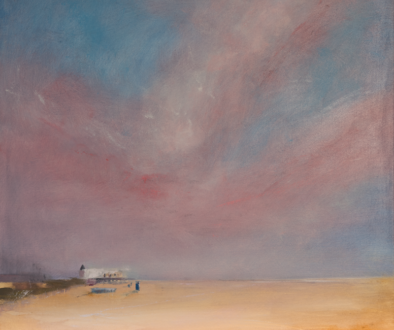TRACEN: More Than a Base, a Legacy
No other branch of the military bestows its newest members with as much authority, challenge, and responsibility as the United States Coast Guard. Primarily tasked with protecting our nation’s borders while stemming the flow of drugs from overseas and ensuring the safety of offshore mariners, a young Coastie could very well find herself or himself in a running gun battle with smugglers a few weeks after graduating from the Coast Guard Training Center Cape May (TRACEN). Others might find themselves conducting life-and-death Search and Rescue missions while commanding one of the service’s small boats or even free-falling from a helicopter as it hovers above a foundering fishing vessel to provide aid or rescue to its crew.
This year the Training Center celebrates its 75th Anniversary. In recognition, the TRACEN leadership team, under the direction of Commanding Officer Captain Warren Judge, has adopted the slogan “Brilliant at the Basics since 1948.”




A newly formed recruit company generally makes its first appearance on the Wednesday morning after their arrival at TRACEN. Having arrived the night before at Philadelphia International Airport from around the world, they head to the USO where they are loaded onto buses for the ride to Cape May. It is always late when their buses arrive at Sexton Hall barracks. There, very impatient people wearing odd-shaped Smokey the Bear hats direct them off the buses to form on a sea of bright yellow triangles painted on the street. These show them how and where to place their feet to form a perfect 45-degree angle. It is their initial introduction to Coast Guard discipline.
The next morning, they are herded from the barracks over to the mess hall, or “dining facility,” by their Smokey-the-Bear-hat-wearing Company Commanders (CCs). They are an awkward and undisciplined lot. The CCs holler and scold to instill some sense of order in what is little more than a mob at this point. These recruits, male and female, are so new that they haven’t been issued uniforms, nor endured that dreaded first haircut. Dressed in a myriad of civilian outfits they all share an expression that seems to ask, “Where am I?” or “Why am I here?”


Formed into a company, they will soon be issued their pennant, a simple white flag emblazoned with a large black letter. This will identify their company, alphabetically, until that special day when they receive their “colors.” This mob of raw recruits will evolve into a company of well-trained, highly motivated United States Coast Guard men and women.
Four times each summer, TRACEN invites the public to witness this transformation at a Sunset Parade, a colorful, inspiring military ceremony. Attendees are serenaded by the Coast Guard Recruit band, thrilled by the Recruit Drill Team, and impressed by the marching of the recruit companies. The ceremony culminates with the firing of a ceremonial cannon and inspirational remarks by the commanding officer, Captain Judge. It is an occasion steeped in history, pageantry, and camaraderie set on Parade Field, adjacent to the Munro statue.


Signalman First Class Douglas Munro remains the only Coast Guardsman to have earned the Medal of Honor, awarded for heroism during combat. Munro was awarded posthumously for his actions during the Battle of Guadalcanal on September 27, 1942. When a battalion of almost 500 Marines attempted to make an end-run around a Japanese stronghold but realized too late that they had underestimated the enemy’s strength. Rather than suffer total annihilation, the Marines requested a water evacuation. Help arrived in the form of young Douglas Munro, who maneuvered his craft onto the beach to provide covering fire while evacuating the Marines. Munro’s boats successfully evacuated all the survivors and the dead, but he himself fell, mortally injured. As he lay dying, Munro was heard to ask, “Did we get them all off?” After receiving an affirmative reply, he smiled and was gone.
Immediately behind the Munro statue, like a silent exclamation point, looms the towering mast of the USCG Cutter Spencer. A remnant of the Coast Guard’s most highly decorated cutter, it serves as a reminder that the nation’s oldest continuous seagoing service is tasked not only with protecting our nation’s borders but with safeguarding its economic and security interests at home and abroad. It is the primary mission of the Coast Guard, the nation’s smallest service, and it will soon rest upon the shoulders of these newly minted Coast Guard men and women who march beneath those outstretched yardarms. Sunset Parades remind us that, since 1790, the Coast Guard has the mission of protecting all mariners on every body of water, from weekend boaters to the largest cargo carrier and everything in between.




Ed Melega is a local man who spent 24 years personifying that mission. On the south side of the Parade Field sits a retired 44’ Motor Lifeboat (MLB). During his Coast Guard career, Melega served as a coxswain aboard this type of vessel. About his most historic rescue, this quiet, humble former Coastie says, “When it’s your life that is being saved, it’s always historic.” Now retired, Ed’s passion for the Coast Guard and the mission has not diminished. Today, Ed can usually be found leading an all-volunteer crew that is restoring MLB 36538, a long-retired 36’ Motor Lifeboat. Movie-goers will recall that another 36’ MLB shared the limelight with Chris Pine and Casey Affleck in the 2016 Disney film The Finest Hours, a film that recounts what is said to have been one of the greatest sea rescues in Coast Guard history. The vessel in that rescue was the MLB 36500, and the person at the helm was a Coast Guardsman named Bernie Webber.
In 1952, Webber (played by Chris Pine the film) was a Petty Officer assigned as a coxswain at Station Chatham near Cape Cod, Massachusetts. In February of that year, a 500’ long World War II tanker, SS Pendelton, split apart in heavy seas. While the bow sank immediately, taking eight members of the crew with it, the stern stayed afloat temporarily, the 33 men aboard in dire need of rescue. The seas were horrendous, especially over the notorious Chatham “bar,” a shallow area that caused waves to jack up to monstrous heights, often over 60’. Webber, along with three volunteers, managed to navigate the MLB 36500 over it but lost their compass and windshield in the process. Nevertheless, Webber located what was left of the Pendelton and managed to bring 32 of 33 survivors aboard the vessel, designed for just 12. For his heroics, Bernie Webber was awarded the Coast Guard’s gold lifesaving medal.
A vessel of the same model was assigned to Cape May until the 70s. The last Petty Officer in charge of it, the late Wayne Adams, spearheaded the restoration until his passing in 2022. The restoration effort earned the moniker, “Float the Boat,” and a dedicated crew of volunteers gives their own time, dollars, and effort to Float the Boat. They epitomize a long tradition of selfless service, pride, and a desire to preserve the legacy of Coast Guardsmen and women like Wayne Adams. It is this spirit and tradition that TRACEN strives to instill in every recruit who passes through Cape May.


The legacy of courage and commitment personified by Coast Guardsmen like Bernie Weber and Douglas Munro is woven throughout TRACEN, especially at the Bernard Webber Seamanship building. Dedicated in 2017, the facility overlooks Cape May Harbor, and it reminds recruits of the courage and legacy of Bernie Webber while instilling in them the basics of seamanship and small boat handling. Seamanship is a core element in TRACEN’s syllabus and a requirement for graduation.
In 2006, Kevin Costner and Ashton Kutcher starred in the film The Guardian. Although based on a true story, the film is essentially fiction. Not fiction, however, is the real-life story of Aviation Survival Technician, 1st Class (1/C AST) Christopher Wilson. Wilson graduated from TRACEN 12 years ago with Company S-185. He recounted his experience during a real-life rescue: “There was one rescue where I employed every bit of my training and stamina. A boat with six anglers fishing in Cape May’s Tuna Tournament got into trouble. Low on fuel and with bilge pumps inoperative, the only way they could avoid being swamped was by heading directly offshore into 8-10’ seas. When their distress call went out, my crew scrambled to the rescue in our MH-65 Dolphin helicopter. Luckily, the fishermen had forwarded a good position, so we found them right away. The 65 is a great helicopter but is limited in how much weight it can carry. Upon arriving over their vessel, we realized that we could only take two survivors. Fortunately, there was another ‘good Samaritan’ vessel nearby willing to take on survivors. So, I went into the water, and I ended up doing a buddy-tow with four of the survivors over to the other boat. Next, I loaded the other two into our rescue basket and hoisted them up to the 65, one at a time.”
Wilson explained that each buddy-tow was like sprinting full-speed for 1,000 meters into 10’ seas. “Even though the whole rescue only took about 45 minutes, I was totally spent. That experience prompted me to develop a special training regime for new rescue swimmers that I call ‘SAR Circuit,’ which blends full-speed sprints with buddy-tows. It is a regime that I teach the aviation survival candidates at the pool.” In the film, actors Costner and Kutcher play rescue swimmers, but Chris Wilson is the real deal.
Further west along Harbor Patrol Road are quays where seven units from the 5th Coast Guard District are homeported in Cape May: three 154’ Fast Response Cutters (FRCs), Angela McShan, Lawrence Lawson, and Rolling Fritch, along with two 47’ coastal patrol boats, the Bonito and Mako, and several smaller patrol and work vessels. Among the newest, most capable vessels in the Coast Guard, the Sentinel-class FRCs are “deepwater” assets since they range farther offshore than smaller units. Manned by a crew of 24, the FRCs mount a Mark 38, 25mm chain gun, and a pair of 50 caliber machine guns for those occasions when something more than a “suggestion” is warranted. All FRCs are named for Coast Guard heroes, and appropriately, the very first FRC was christened as the USCG Bernard C. Webber. Immediately adjacent to the quays sits what is reported to be the oldest original building on board TRACEN, the Captain’s Quarters, currently the home to Captain Judge.


As Commanding Officer of the Coast Guard’s only enlisted training base, Captain Judge is responsible not only for turning out approximately 4,000 motivated Coast Guardsmen every year, but also coordinates the needs and activities of 14 tenant commands, such as the busy Small Boat Station, Aids to Navigation, and those operational vessels from the 5th Coast Guard District listed above.
Captain Judge took over as the 33rd Commanding Officer of TRACEN in July 2022. Known within the service as a “Mustang,” Captain Judge enlisted in the Coast Guard and completed basic training at TRACEN, Cape May with Company M-123 in 1986. He went on to complete his bachelor’s degree in computer science, earning an officer’s commission. He was assigned to assist in the rebuilding of the lower Gulf Coast after Hurricane Katrina. From 2009 through 2012, he served as Presidential Response Officer for President Barack Obama. Captain Judge encourages everyone in his command to live by his three key principles:
Take pride in everything they do: pride equals professionalism, and professionalism results in dedicated efforts.
Everyone should strive to earn their Double “E” degree: Executing Excellence
Always deliver “Presidential Customer Service” to everyone who crosses the threshold.
Statistically, Captain Judge’s team can be judged by its success. During an era when all military services are struggling to fill their recruit quotas, and some are indeed falling short, TRACEN has not only exceeded its goals but has maintained an enviable graduation rate of over 81%. Much of the credit goes to a Captain who makes it a point to sign every graduation certificate and adds a personal, motivational message. Captain Judge is a leader who does more than complete the mission. He lives it.

As is typical of Coast Guard spouses, Captain Judge’s wife, Angela, contributes to the local community. A volunteer at the city’s food pantry, she also sits on its Environmental Commission. She is well suited for it, having earned her advanced degrees in city affairs, followed by a stretch as Assistant City Manager for Elizabeth City, North Carolina. She served as Deputy City Manager of Rockville, Maryland, until her husband received his current assignment. Their message: “Cape May has been a Coast Guard hometown since 2015, and we thank the entire community for their continued support.”
Mrs. Judge sits on the Environmental Commission with Nature Center Director, Gretchen Whitman, who has worked closely with TRACEN for over 25 years. It makes sense considering that the Center is surrounded by Coast Guard-dependent housing. Twice a year for the past two decades, recruit companies have marched from the Base down to the Center for a day of volunteer community service. For Whitman, it is a welcome source of much-needed support. For the CCs it is an opportunity to identify their company leaders, and for the recruits, it is a couple of hours away from the constant scrutiny of their CCs. For over 20 years, the Nature Center has given back to its Coast Guard neighbor through the Good Neighbor Fund, awarding camp scholarships to Coast Guard-dependent children. It is a symbiotic and treasured relationship. In 2015 when the Coast Guard designated Cape May as its “Hometown,” Whitman was declared one of their “Hometown Heroes.”
In a very real sense, the entire Cape May community are “Coast Guard Heroes.” When the pandemic canceled most in-person activities, this included the Friday afternoon graduation ceremonies at the Base. Unwilling to allow their newly minted Coasties to be sent on their way without fanfare, Cape May citizens commenced an impromptu demonstration of support by gathering at the corner of Pennsylvania and Pittsburgh Avenues every Friday afternoon after graduation to show their support for the young Coast Guard men and women departing TRACEN to their first assignments. The gatherings continue as a spontaneous outpouring of support and appreciation for recent graduates.

“International Alphabet Signal Flags” are colorful pennants that represent every letter of the alphabet and are the quest of every recruit company that comes through TRACEN. When their company was first formed almost two months previously, it was identified by a stark white flag with a large black letter. This had been their collective identity, and they knew that it would remain so until their Company Commanders decided that they had finally “earned their colors.”
The day that a company earns its colors is a heady and memorable event. One Company Commander (CC) chose Cape May’s Fisherman’s Memorial as the setting for her company to earn their colors. Forming them around the base of the statue at the Memorial, back to the harbor, she reminded them that as Coast Guardsmen, their duty was to “protect, to serve, and to save,” even at the risk of their own lives. Meanwhile, her assistant placed a staff with the colors affixed in the sand behind the company. When finished, the CC pointed toward the harbor and told her company to, “claim their colors.” Their enthusiasm and excitement in that moment were palpable.
They were now, officially and forever, Coast Guardsmen.



